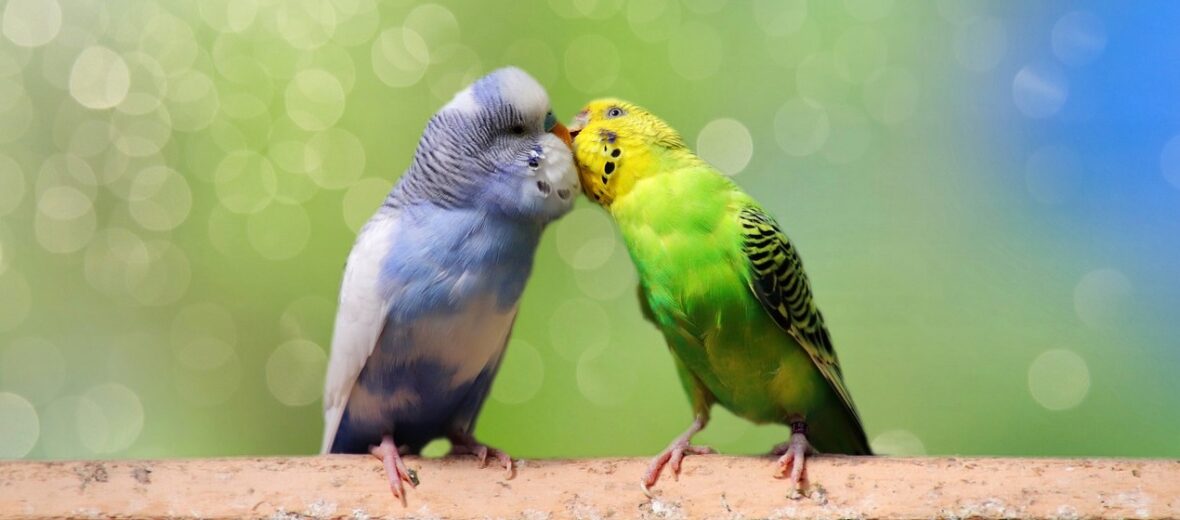
The budgerigar, aka budgie, or more famously – parakeet, is actually a member of the parrot family. There are 115 known species of parakeet. But we will be focusing on the budgerigar or common parakeet. The kind you find in pet stores all over the world. In captivity, these sweet and social birds have little fear of humans and can even, with some patience, be taught to speak. Although their vocabulary is no where near as verbose and clear as an African Grey parrot, they still try their best. Due to their massive, stable numbers, invasive nature, and worldwide distribution, budgies are listed as Least Concern by the IUCN; and their numbers are increasing.
First the Stats…
Scientific name: Melopsittacus undulatus
Weight: Up to 1.4 ounces
Length: Up to 7.1 inches
Wingspan: Up to 12 inches
Lifespan: Up to 15+ years
Now on to the Facts!
1.) Due to their ease of care, friendly, social demeanor, and lack of expense these beautiful little avians are the number 1 choice for bird owners, worldwide.
2.) There are approximately 16 known types (breeds) of parakeet. They are divided into 2 groups: green and blue. “But why do I see yellow parakeets”, you ask? The green group contains both green and yellow. Not sure why they decided not to include a “yellow” group. But there you have it.
3.) Besides being vocal, these little critters also use body language to express mood and state of health. Hopping, open wings, standing on 1 foot, tail to 1 side with feathers raised, feathers flattened against their body, cleaning feathers, motionless, and silence are a few types of behaviors exhibited by parakeets. Next time you see one, see if you can notice their behavior.
4.) The budgerigar, cinnamon, ino, opaline, albino, and lutino are the most common breeds of budgie.
5.) Parakeets are monogamous (mate for life).
But wait, there’s more on the budgerigar!
6.) If kept as pets, it is best to keep 2 or more together. These are highly social creatures and become depressed, and even sick, if kept alone.
7.) The typical parakeet is covered with around 3,000 feathers.
Did you know…?
Parakeets can, believe it or not, fall ill to some of the same illnesses that humans can be afflicted with. Illnesses like asthma, depression, diabetes, bronchitis, and even anemia. However, they are the avian versions of these illnesses and aren’t zoonotic (transmissible to humans).
8.) Males and females are differentiated by the cere, the small bit of flesh above their beak. The female’s is tan or brownish and the male’s is blue. Another method of sexing parakeets is that males tend to be more talkative while females tend to chew more on things.
9.) A parakeet can rotate it’s head 180°!
10.) Budgerigars eat seeds, eucalyptus leaves, fruits, a variety of ferns, and insects; making them omnivores (eat plant and animal matter).
But wait, there’s still more on the budgerigar!
11.) 101.84°F is a normal, healthy body temperature for a budgie.
12.) While not nearly as fast as a hummingbird, a budgie’s heart beats at 200 BPM!
Did you know…?
Budgies poop about every 15 minutes plus or minus. Hey, when your metabolism is fast, that food goes right though you.
13.) In the wild, parakeets will roll in wet grass to clean themselves.
14.) These social little birds can form flocks comprised of thousands of other budgies.
15.) Snakes and birds of prey hunt budgerigars.
But wait, there’s a little more on the budgerigar!
16.) Breeding typically takes place during the rainy season, when food is most plentiful. Breeding can happen up to twice a year.
17.) Females lay up to 8 eggs throughout a period of up to 16 days.
18.) Eggs hatch after about 3 weeks.
19.) The male will gather food for the mother and chicks, so mom can incubate the eggs and tend to the young hatchlings, who leave the nest after around 5 weeks.
20.) Some species of parakeets are considered pests, due to the amount of crop destruction they cause annually.
Now a Short Budgerigar Video!
Video courtesy of AviBirds Team.
Also, check out the Critter Science YouTube channel. Videos added frequently!
Want to suggest a critter for me to write about? Let me know here.



